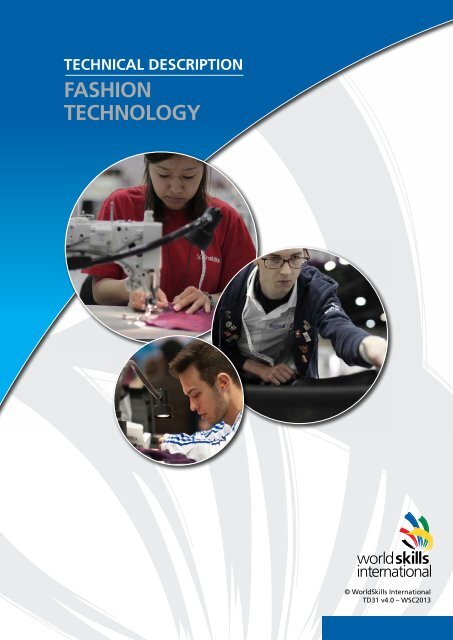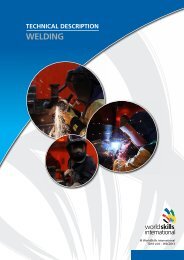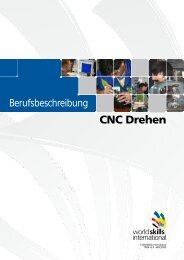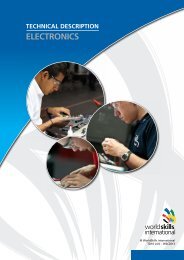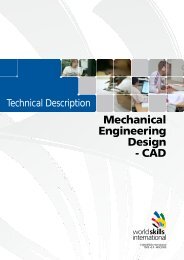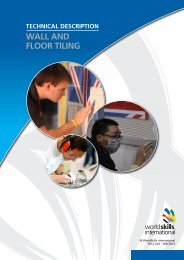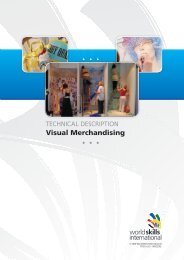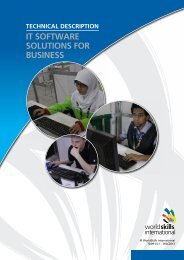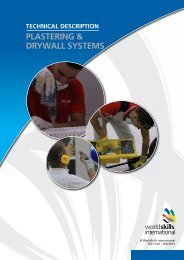TECHNICAL DESCRIPTION fASHION TECHNOLOgy
TECHNICAL DESCRIPTION fASHION TECHNOLOgy
TECHNICAL DESCRIPTION fASHION TECHNOLOgy
Create successful ePaper yourself
Turn your PDF publications into a flip-book with our unique Google optimized e-Paper software.
<strong>TECHNICAL</strong> <strong>DESCRIPTION</strong><br />
<strong>fASHION</strong><br />
<strong>TECHNOLOgy</strong><br />
© WorldSkills International<br />
TD31 v4.0 – WSC2013
WorldSkills International, by a resolution of the Technical Committee and in accordance with the<br />
Constitution, the Standing Orders and the Competition Rules, has adopted the following minimum<br />
requirements for this skill for the WorldSkills Competition.<br />
The Technical Description consists of the following:<br />
1. INTRODUCTION ............................................................................................... 2<br />
2. COMPETENCY AND SCOPE OF WORK ......................................................... 2<br />
3. THE TEST PROJECT ........................................................................................ 4<br />
4. SKILL MANAGEMENT AND COMMUNICATION ............................................. 6<br />
5. ASSESSMENT .................................................................................................. 7<br />
6. SKILL-SPECIFIC SAFETY REQUIREMENTS .................................................. 8<br />
7. MATERIALS & EQUIPMENT ............................................................................ 8<br />
8. MARKETING THE SKILL TO VISITORS AND MEDIA ................................... 10<br />
Effective 11.10.11<br />
John Shiel<br />
Chair Technical Committee<br />
WSC2013_TD31_EN<br />
Date: 11.10.11 – v4.0<br />
Stefan Praschl<br />
Vice Chair Technical Committee<br />
© WorldSkills International (WSI) reserves all rights in documents developed for or on behalf of WSI, including translation and electronic<br />
distribution. This material may be reproduced for non-commercial vocational and educational purposes provided that the WorldSkills<br />
International logo and copyright notice are left in place.<br />
Copyright © WorldSkills International. All rights reserved.<br />
Fashion Technology<br />
1 of 10
1. INTRODUCTION<br />
1.1 Name and description of skill<br />
1.1.1 The name of the skill is<br />
WSC2013_TD31_EN<br />
Date: 11.10.11 – v4.0<br />
Fashion Technology<br />
1.1.2 Description of skill<br />
Fashion Technology professionals work closely with clients either in production or custom<br />
garments for individual clients. They create garments, using their knowledge of materials and<br />
accessories, fashion and colour trends and work within the parameters and requirements of the<br />
client / company they are producing the work for.<br />
Fashion Technology professionals working in small firms usually perform most of the technical<br />
pattern making, cutting and sewing task in addition to designing clothing<br />
They are technically skilled garment producers who are highly efficient at handling different<br />
materials and are skilled in using both industrial machine and hand sewing techniques.<br />
Requirements include: knowledge of fashion, creativity, imagination together with professional level<br />
technical skills.<br />
1.2 Scope of application<br />
1.2.1 Every Expert and Competitor must know this Technical Description.<br />
1.2.2 In the event of any conflict within the different languages of the Technical Descriptions, the English<br />
version takes precedence.<br />
1.3 Associated documents<br />
1.3.1 As this Technical Description contains only skill-specific information it must be used in association<br />
with the following:<br />
� WSI - Competition Rules<br />
� WSI - Online resources as indicated in this document<br />
� Host Country - Health and Safety regulations<br />
2. COMPETENCY AND SCOPE OF WORK<br />
The Competition is a demonstration and assessment of the competencies associated with this skill.<br />
The Test Project consists of practical work only.<br />
2.1 Competency specification<br />
General<br />
Competitors shall have the knowledge and understanding to:<br />
� Create and understand technical drawings<br />
� Plan work effectively to achieve task completion within a given time<br />
� Select appropriate equipment / tools to create design style<br />
� Maintain a safe work environment<br />
Copyright © WorldSkills International. All rights reserved.<br />
Fashion Technology<br />
2 of 10
WSC2013_TD31_EN<br />
Date: 11.10.11 – v4.0<br />
Fashion designing<br />
Knowledge and understanding:<br />
� Understanding of the design elements of ladies’ outfits and accessories<br />
Competitors shall be able to:<br />
� Research fashion trends and themes analysis<br />
� Creating theme board and trend board<br />
� Set designs for different target markets<br />
� Create technical drawings<br />
� Coordinate fabric and colours<br />
� Present ideas<br />
� Identify different types of fabric (e.g. silk, knitted jersey, Gore-Tex, denim, wool, etc.)<br />
� Apply different types of fabric on different designs<br />
� Identify different types of accessories (e.g. buttons, zippers, lace, ribbon, etc)<br />
� Apply different accessories on different designs<br />
� Design various types of ladies’ fashion garments (e.g. tailored jackets, evening dress, skirts,<br />
pants, etc)<br />
� Plan working procedures effectively to achieve task completion within the given time<br />
Pattern construction/draping<br />
Knowledge and understanding:<br />
� Understanding of the construction of ladies’ outfits by 2D paper pattern or 3D draping<br />
Competitors shall be able to:<br />
� Construct and alter basic patterns for various types of ladies’ fashion garments (e.g. tailored<br />
jackets, evening dress, skirts, pants, etc) or<br />
� Drape on dummies for various types of ladies’ fashion garments (e.g. tailored jackets, evening<br />
dress, skirts, pants, etc)<br />
� Select the best method of construction appropriate to different fabric and design<br />
� Mark accurately<br />
� Measure accurately<br />
� Cut different fabric and material accurately<br />
� Fit ladies’ garment to specified sizes<br />
� Plan working procedures effectively to achieve task completion within the given time<br />
Sewing and finishing techniques<br />
Knowledge and understanding:<br />
Knowledge of high quality sewing and finishing of ladies’ outfits<br />
Competitors shall be able to:<br />
� Sew and finish various types of ladies’ fashion garments (e.g. tailored jackets, evening dress,<br />
skirts, pants, etc)<br />
� Use various industrial machines effectively and safely (e.g. sewing machine, interlocking<br />
machine, iron, fusing press, etc)<br />
� Select appropriate equipment and tools to create the designed style<br />
� Finish parts of garments with hand sewing (e.g. hem, buttonholes, embroidery, etc.)<br />
� Apply fusing (interlining) appropriately and effectively to different parts of the designed style<br />
� Construct linings and facings appropriate according to the style of the designed garments<br />
� Press garments effectively<br />
� Plan working procedures effectively to achieve task completion within the given time<br />
Copyright © WorldSkills International. All rights reserved.<br />
Fashion Technology<br />
3 of 10
2.2 Theoretical knowledge<br />
2.2.1 Theoretical knowledge is required but not tested explicitly.<br />
2.2.2 Knowledge of rules and regulations is not examined.<br />
2.3 Practical work<br />
WSC2013_TD31_EN<br />
Date: 11.10.11 – v4.0<br />
The practical work to be carried out by the Competitor will include:<br />
� Preparation and creation technical drawing as specified in the Test Project<br />
� Design and construct garments and/or elements which are set to a theme specified in the Test<br />
Project<br />
� Construction of mandatory garments and/or elements that are specified in the Test Project<br />
� Design, creation paper pattern or drape of the garment as specified in the Test Project<br />
� Measurement, layout and cutting fabric as specified in the Test Project<br />
� Use various industrial machines efficiently to construct garments specified in the Test Project<br />
� Finish a small number of garments with hand sewing<br />
� Presentation the completed Test Project neatly.<br />
3. THE TEST PROJECT<br />
3.1 Format / structure of the Test Project<br />
The format of the Test Project is a single Test Project with separately assessed modules.<br />
The Test Project must contain at least 3 modules and be able to be assessed throughout the<br />
Competition.<br />
3.2 Test Project design requirements<br />
� The Host Member must provide measurements of the dummy (Bust: Waist: Hip: Back Length).<br />
This must be provided by the Workshop Supervisor 1 month after the selection of the test<br />
project has taken place.<br />
� All materials and fabrics must be suitable for the Test Project and commercially available. The<br />
Competition Organiser will provide contacts of supplier or agent for fabric.<br />
� The Test Project must include fabrics of different weight.<br />
� The Test Project must be able to match with the concept of providing a ‘mystery box’ to all<br />
Competitors. The ‘mystery box’ will contain different types of trimmings and accessories to test<br />
the creativity design skill.<br />
� The Host Member has to send swatches of the chosen fabrics and trims (a swatch 30cm x<br />
30cm should be provided of each fabric and at least 50cm length in full width if the fabric has<br />
large pattern) at least 3 months prior to the Competition.<br />
� The Test Project must include a mandatory garment or part of garment for objective marking.<br />
� The Test Project must include a non mandatory garment or part of garment (creativity and<br />
design) for subjective marking.<br />
� The Test Project must include a blind marking section such as mandatory garment.<br />
� All materials (such as fabric, CD, digital and paper pattern) relating to the chosen Test Project to<br />
be sent via registered mail by the Competition Organiser.<br />
3.3 Test Project development<br />
The Test Project MUST be submitted using the templates provided by WorldSkills International<br />
(http://www.worldskills.org/competitionpreparation). Use the Word template for text documents and<br />
DWG template for drawings.<br />
Copyright © WorldSkills International. All rights reserved.<br />
Fashion Technology<br />
4 of 10
3.3.1 Who develops the Test Project / modules<br />
The Test Project / modules are developed by:<br />
WSC2013_TD31_EN<br />
Date: 11.10.11 – v4.0<br />
All Experts and must be validated as defined in 3.5.<br />
3.3.2 How and where is the Test Project / modules developed<br />
Independently by the Experts.<br />
3.3.3 When is the Test Project developed<br />
The Test Project is developed according to the timeline below.<br />
Time Activity<br />
16 months prior to the Competition Test Project proposals are uploaded to the Discussion<br />
Forum. Test Project proposals are uploaded to the<br />
Discussion Forum for consideration and voting by the<br />
Experts.<br />
9 months prior to the Competition Discussions regarding the proposals finish, and a vote to<br />
select the Test Project is conducted.<br />
6 months prior to the Competition The Test Project is circulated on the WSI website.<br />
At the Competition 30% change is agreed to by the vote of the Experts.<br />
3.4 Test Project marking scheme<br />
Each Test Project must be accompanied by a marking scheme proposal based on the assessment<br />
criteria defined in Section 5.<br />
3.4.1 The marking scheme proposal is developed by the person(s) developing the Test Project. The<br />
detailed and final marking scheme is developed and agreed by all Experts at the Competition.<br />
3.4.2 Marking schemes should be entered into the CIS prior to the Competition.<br />
3.5 Test Project validation<br />
Test projects proposals found not to be compliant with 3.2 and 3.6 will have the opportunity during<br />
this time make the necessary changes.<br />
It must be demonstrated that the Test Project/modules can be completed within the material,<br />
equipment, knowledge and time constraints. This will be demonstrated by a sample of the<br />
mandatory elements of the garment or a complete garment. This is provided by the Expert who<br />
designed the Test Project.<br />
Each mandatory garment or piece of garment has to be displayed as a sample at the Competition<br />
site, for the Competitor and the public to see.<br />
3.6 Test Project selection<br />
The Test Project is selected as follows:<br />
By vote on the Discussion Forum 9 months prior to the Competition.<br />
To be eligible for selection each submitted Test Project must be complete and include a digital<br />
copy of the Test Project, a digital copy of the entire pattern in DXF format, a detailed marking scale,<br />
professional drawings and technical drawings and a sample of the mandatory elements of garment<br />
or a complete garment.<br />
Copyright © WorldSkills International. All rights reserved.<br />
Fashion Technology<br />
5 of 10
3.7 Test Project circulation<br />
The Test Project is circulated via WorldSkills International website as follows:<br />
WSC2013_TD31_EN<br />
Date: 11.10.11 – v4.0<br />
6 months before the current Competition.<br />
3.8 Test Project coordination (preparation for Competition)<br />
Coordination of the Test Project will be undertaken by:<br />
Coordination of the Test Project will be undertaken by the Expert whose Test Project has been<br />
selected and the Host Member.<br />
3.9 Test Project change at the Competition<br />
Due to the TP being circulated to Competitors 6 months prior to the Competition it is necessary to<br />
make a 30% change at the Competition. Experts on the Jury Panel may submit ideas for the 30%<br />
change. Experts will vote on the changes to be made upon arrival at the Competition.<br />
3.10 Material or manufacturer specifications<br />
� All materials (such as fabric, CD, digital and paper pattern) relating to the chosen Test Project to<br />
be sent via registered mail by the Competition Organiser at least 3 months prior to the<br />
Competition. Swatches must be 30cm x 30cm of the chosen fabrics and at least 50cm length in<br />
full width if the fabric has large pattern.<br />
� All materials and fabrics must be suitable for the Test Project and commercially available.<br />
� The Competition Organiser will provide contacts of supplier or agent for fabric at least 3 months<br />
prior to the Competition.<br />
� The Competition Organiser is required to send samples at least 3 months prior to the<br />
Competition.<br />
4. SKILL MANAGEMENT AND COMMUNICATION<br />
4.1 Discussion Forum<br />
Prior to the Competition, all discussion, communication, collaboration and decision making<br />
regarding the skill must take place on the skill-specific Discussion Forum<br />
(http://www.worldskills.org/forums). All skill-related decisions and communication are only valid if<br />
they take place on the forum. The Chief Expert (or an Expert nominated by the Chief Expert) will be<br />
moderator for this forum. Refer to Competition Rules for the timeline of communication and<br />
competition development requirements.<br />
4.2 Competitor information<br />
All information for registered Competitors is available from the Competitor Centre<br />
(http://www.worldskills.org/competitorcentre).<br />
This information includes:<br />
� Competition Rules<br />
� Technical Descriptions<br />
� Test Projects<br />
� Other Competition-related information<br />
4.3 Test Projects<br />
Circulated Test Projects will be available from worldskills.org<br />
(http://www.worldskills.org/testprojects) and the Competitor Centre<br />
(http://www.worldskills.org/competitorcentre).<br />
Copyright © WorldSkills International. All rights reserved.<br />
Fashion Technology<br />
6 of 10
4.4 Day-to-day management<br />
The day-to-day management is defined in the Skill Management Plan that is created by the Skill<br />
Management Team led by the Chief Expert. The Skill Management Team comprises the Jury<br />
President, Chief Expert and Deputy Chief Expert. The Skill Management Plan is progressively<br />
developed in the six months prior to the Competition and finalised at the Competition by agreement<br />
of the Experts. The Skill Management Plan can be viewed in the Expert Centre<br />
(http://www.worldskills.org/expertcentre).<br />
5. ASSESSMENT<br />
WSC2013_TD31_EN<br />
Date: 11.10.11 – v4.0<br />
This section describes how the Experts will assess the Test Project / modules. It also specifies the<br />
assessment specifications and procedures and requirements for marking.<br />
5.1 Assessment criteria<br />
This section defines the assessment criteria and the number of marks (subjective and objective)<br />
awarded. The total number of marks for all assessment criteria must be 100.<br />
5.2 Subjective marking<br />
Section Criterion Marks<br />
Subjective<br />
(if applicable)<br />
Objective Total<br />
A Design 10 10<br />
B Realisation of Patterns 5 15 20<br />
C Construction 10 35 45<br />
D Appearance 15 15<br />
E Level of Difficulty 10 10<br />
Scores are awarded on a scale of 1 to 10<br />
5.3 Skill assessment specification<br />
Criterion A – Design<br />
Experts will assess the following aspects subjectively:<br />
� Creativity<br />
� Original concept/innovation<br />
� Use of supplied materials<br />
� Use of the elements and principles of design<br />
� Technical drawings<br />
� Fabric and colour co-ordination<br />
Total = 50 50 100<br />
Criterion B – Realisation of Patterns<br />
Experts will assess the following aspects both subjectively and objectively:<br />
� Accurate measurement<br />
� Layout and cutting<br />
� Draping<br />
� Pattern accuracy<br />
� Pattern information (seam allowances, grainline, cutting instructions, notches etc)<br />
Copyright © WorldSkills International. All rights reserved.<br />
Fashion Technology<br />
7 of 10
WSC2013_TD31_EN<br />
Date: 11.10.11 – v4.0<br />
Criterion C – Construction<br />
Experts will assess the following aspects both subjectively and objectively:<br />
� Measurements<br />
� Lay-out and cutting<br />
� Seams and matching of junctions<br />
� Execution of construction<br />
� Quality of construction<br />
Criterion D – Appearance<br />
Experts will assess the following aspects both subjectively:<br />
� General pressing<br />
� Drape and shape of the garment<br />
� Quality of the sewing and finishing<br />
Criterion E – Level of Difficulty<br />
Experts will assess the following aspects both subjectively:<br />
� Concept realisation (pattern)<br />
� Construction techniques<br />
5.4 Skill assessment procedures<br />
Prior the Competition, the Chief Expert will explain the assessment method to all Experts.<br />
The Chief Expert will divide all the Experts into teams for purpose of marking and setting up<br />
marking schedules. The teams are to be divided between experienced Experts and new Experts.<br />
All the Experts should assess the same aspects for all the Competitors.<br />
All Experts assess the same percentages of the marks.<br />
Objective marking will be marked by teams according to criteria set, e.g. measurements, as<br />
detailed in paragraph 5.3.<br />
Subjective marking will be marked by teams using flash cards as detailed in paragraph 5.2.<br />
6. SKILL-SPECIFIC SAFETY REQUIREMENTS<br />
Refer to Host Country Health & Safety documentation for Host Country regulations.<br />
The following skill-specific safety requirement must also be adhered to.<br />
� The electrical cord should not be in the way and must be taped to the floor and the table.<br />
� 1000 Lux lighting over all work areas<br />
7. MATERIALS & EQUIPMENT<br />
7.1 Infrastructure List<br />
The Infrastructure List details all equipment, materials and facilities provided by the Host Country.<br />
The Infrastructure List is online (http://www.worldskills.org/infrastructure/).<br />
The Infrastructure List specifies the items & quantities requested by the Experts for the next<br />
Competition. The Competition Organiser will progressively update the Infrastructure List specifying<br />
the actual quantity, type, brand/model of the items. Items supplied by the Competition Organiser<br />
are shown in a separate column.<br />
Copyright © WorldSkills International. All rights reserved.<br />
Fashion Technology<br />
8 of 10
WSC2013_TD31_EN<br />
Date: 11.10.11 – v4.0<br />
At each Competition, the Experts must review and update the Infrastructure List in preparation for<br />
the next Competition. Experts must advise the Technical Director of any increases in space and/or<br />
equipment.<br />
At each Competition, the Technical Observer must audit the Infrastructure List that was used at<br />
that Competition.<br />
The Infrastructure List does not include items that Competitors and/or Experts are required to bring<br />
and items that Competitors are not allowed to bring – they are specified below.<br />
7.2 Materials, equipment and tools supplied by Competitors in their toolbox<br />
� Tailor’s chalk<br />
� Pencils<br />
� Tracing wheel<br />
� Tracing paper<br />
� Thimble<br />
� Scissors (paper, fabric, electric scissors or rotary cutter)<br />
� Rulers<br />
� Pins<br />
� Stitch ripper<br />
� Magnetic edge-guide<br />
� Hand sewing needles<br />
� Pressing equipment (hams, bias tape maker etc)<br />
� Weights<br />
� Clock / Timer<br />
� A selection of drawing tools (coloured pencils etc)<br />
� Patternmaking construction tools (calculator, rulers, curves etc)<br />
� Loop turner<br />
� Screwdrivers<br />
This list is a suggestion of tools for Competitors to bring however it is not exclusive.<br />
The toolbox will be checked by the Experts every day.<br />
The use of equipment used to create specialised fabrications according to a Competitor’s design<br />
must be proposed and discussed on the forum and during the familiarisation period by the Experts.<br />
If a Competitor needs special tools unique to their own country/region then the tools must be made<br />
available (brought by the Expert/Competitor) for every Competitor on Familiarisation Day C-2.<br />
7.3 Materials, equipment and tools supplied by Experts<br />
Not applicable<br />
7.4 Materials & equipment prohibited in the skill area<br />
No Competitor is allowed to bring any kind of equipment, fabric, tape, thread, pattern pieces,<br />
slopper, books, notes or samples. If any of these are found they will be taken away prior to and<br />
during the Competition.<br />
See note above*<br />
7.5 Proposed workshop and workstation layouts<br />
Workshop layouts from London are available at:<br />
http://www.worldskills.org/index.php?option=com_halls&Itemid=540<br />
Copyright © WorldSkills International. All rights reserved.<br />
Fashion Technology<br />
9 of 10
WSC2013_TD31_EN<br />
Date: 11.10.11 – v4.0<br />
Workshop layout:<br />
8. MARKETING THE SKILL TO VISITORS AND MEDIA<br />
8.1 Maximising visitor and media engagement<br />
To maximise visitor and media engagement the following ideas will be considered:<br />
� Display screens<br />
� Test Project descriptions<br />
� Enhanced understanding of Competitor activity<br />
� Competitor profiles<br />
� Daily reporting of competition status<br />
� Fashion show towards the end of the Competition<br />
� The public votes for the “Visitor’s Award”<br />
8.2 Sustainability<br />
� Recycling<br />
� Use of ‘green’ materials<br />
� Use of completed Test Projects after Competition<br />
Copyright © WorldSkills International. All rights reserved.<br />
Fashion Technology<br />
10 of 10


